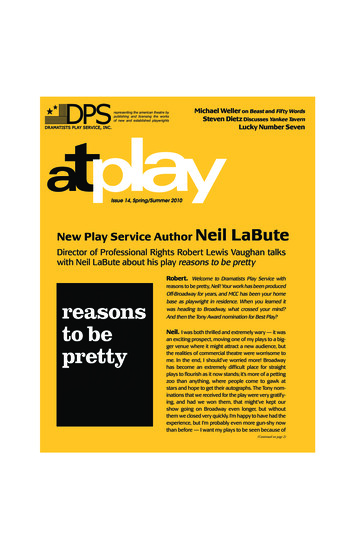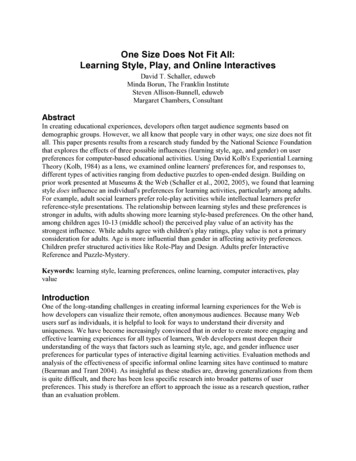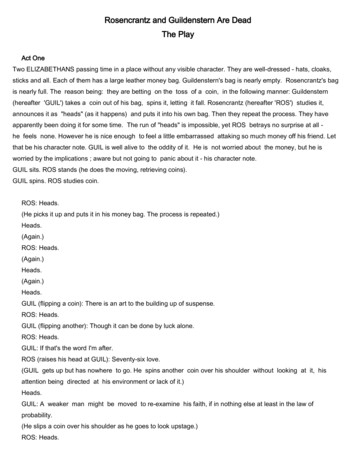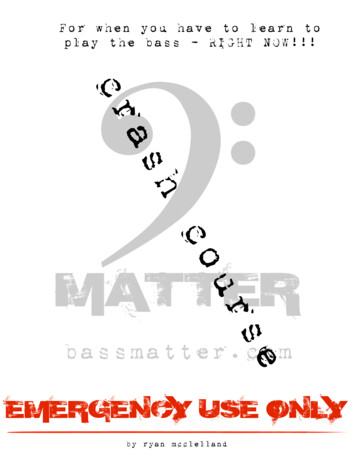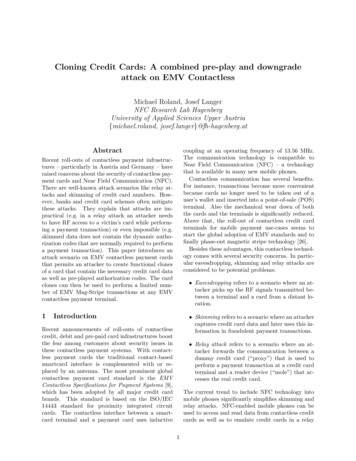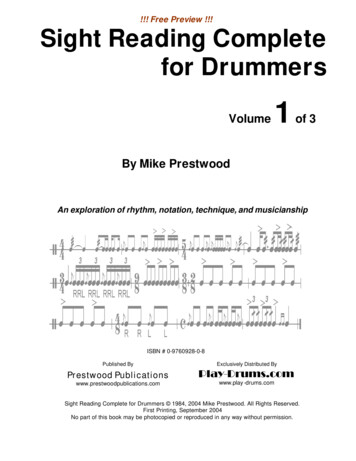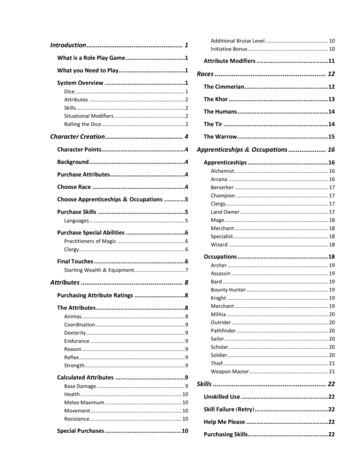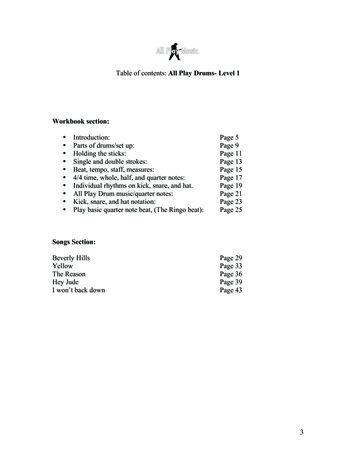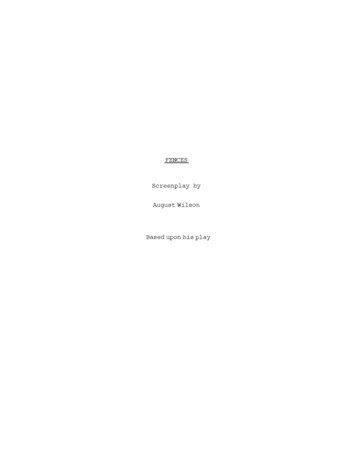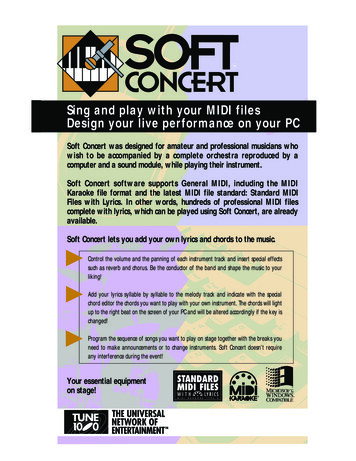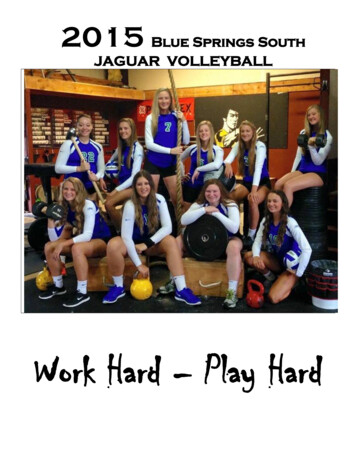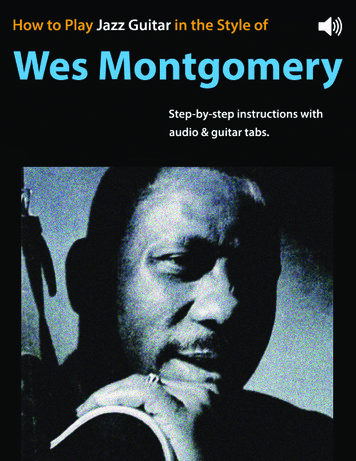
Transcription
How to Play in the Style of Wes Montgomery
Sample PagesThis pdf contains sample pages from the ebook How to Play in the Style of Wes Montgomery.To get the full ebook, click here.How to Play in the Style of Wes Montgomery
ContentsChapter 1 – Introduction. . . . . . . . . . . . . . . . . . . . . . . . . . . . . . . . . . . . . . . . . . . . . . . . . . . . . . . . 4How to Use This Book?. . . . . . . . . . . . . . . . . . . . . . . . . . . . . . . . . . . . . . . . . . . . . . . . . . . . . . . . . . . . . . . . 4Biography. . . . . . . . . . . . . . . . . . . . . . . . . . . . . . . . . . . . . . . . . . . . . . . . . . . . . . . . . . . . . . . . . . . . . . . . . . . . 6Wes Montgomery’s Guitars and Amps. . . . . . . . . . . . . . . . . . . . . . . . . . . . . . . . . . . . . . . . . . . . . . . 13Chapter 2 – Single Note Soloing . . . . . . . . . . . . . . . . . . . . . . . . . . . . . . . . . . . . . . . . . . . . . . . . 17Blues Scales. . . . . . . . . . . . . . . . . . . . . . . . . . . . . . . . . . . . . . . . . . . . . . . . . . . . . . . . . . . . . . . . . . . . . . . . 19Bebop scales. . . . . . . . . . . . . . . . . . . . . . . . . . . . . . . . . . . . . . . . . . . . . . . . . . . . . . . . . . . . . . . . . . . . . . . 31Wes Montgomery’s Use of Guide Tones. . . . . . . . . . . . . . . . . . . . . . . . . . . . . . . . . . . . . . . . . . . . . . 473 to 9 Arpeggios. . . . . . . . . . . . . . . . . . . . . . . . . . . . . . . . . . . . . . . . . . . . . . . . . . . . . . . . . . . . . . . . . . . . 56Upper Structure Triads. . . . . . . . . . . . . . . . . . . . . . . . . . . . . . . . . . . . . . . . . . . . . . . . . . . . . . . . . . . . . . 61The Minorization of Dominant Chords . . . . . . . . . . . . . . . . . . . . . . . . . . . . . . . . . . . . . . . . . . . . . . 67Chapter 3 – Octave Soloing. . . . . . . . . . . . . . . . . . . . . . . . . . . . . . . . . . . . . . . . . . . . . . . . . . . . . 75Pentatonic and Blues Octave Ideas. . . . . . . . . . . . . . . . . . . . . . . . . . . . . . . . . . . . . . . . . . . . . . . . . . 77Arpeggio Octave Ideas . . . . . . . . . . . . . . . . . . . . . . . . . . . . . . . . . . . . . . . . . . . . . . . . . . . . . . . . . . . . . 83Scale Octave Ideas. . . . . . . . . . . . . . . . . . . . . . . . . . . . . . . . . . . . . . . . . . . . . . . . . . . . . . . . . . . . . . . . . . 89Rhythmic Variations. . . . . . . . . . . . . . . . . . . . . . . . . . . . . . . . . . . . . . . . . . . . . . . . . . . . . . . . . . . . . . . . 96Pedal Tone Techniques . . . . . . . . . . . . . . . . . . . . . . . . . . . . . . . . . . . . . . . . . . . . . . . . . . . . . . . . . . . . 102Wes Octave Sample Solo. . . . . . . . . . . . . . . . . . . . . . . . . . . . . . . . . . . . . . . . . . . . . . . . . . . . . . . . . . .108How to Play in the Style of Wes Montgomery
Chapter 4 – Chord Soloing . . . . . . . . . . . . . . . . . . . . . . . . . . . . . . . . . . . . . . . . . . . . . . . . . . . . 113Common Chord Shapes . . . . . . . . . . . . . . . . . . . . . . . . . . . . . . . . . . . . . . . . . . . . . . . . . . . . . . . . . . . 115Chord Scales. . . . . . . . . . . . . . . . . . . . . . . . . . . . . . . . . . . . . . . . . . . . . . . . . . . . . . . . . . . . . . . . . . . . . . 127Diminished Passing Chords. . . . . . . . . . . . . . . . . . . . . . . . . . . . . . . . . . . . . . . . . . . . . . . . . . . . . . . . 133Bluesy Chord Lines. . . . . . . . . . . . . . . . . . . . . . . . . . . . . . . . . . . . . . . . . . . . . . . . . . . . . . . . . . . . . . . . 140Major and Minor ii V I Lines . . . . . . . . . . . . . . . . . . . . . . . . . . . . . . . . . . . . . . . . . . . . . . . . . . . . . . . . 144Wes Chord Soloing Sample Chorus. . . . . . . . . . . . . . . . . . . . . . . . . . . . . . . . . . . . . . . . . . . . . . . . . 148Chapter 5 – Wes Tunes and Progressions . . . . . . . . . . . . . . . . . . . . . . . . . . . . . . . . . . . . . . . 157The Three Tier Soloing Approach. . . . . . . . . . . . . . . . . . . . . . . . . . . . . . . . . . . . . . . . . . . . . . . . . . . 159Common Wes Progressions. . . . . . . . . . . . . . . . . . . . . . . . . . . . . . . . . . . . . . . . . . . . . . . . . . . . . . . . 168Four on Six Chord Changes. . . . . . . . . . . . . . . . . . . . . . . . . . . . . . . . . . . . . . . . . . . . . . . . . . . . . . . . 172Wes Coast Blues Chord Changes. . . . . . . . . . . . . . . . . . . . . . . . . . . . . . . . . . . . . . . . . . . . . . . . . . . 177Twisted Blues Chord Changes. . . . . . . . . . . . . . . . . . . . . . . . . . . . . . . . . . . . . . . . . . . . . . . . . . . . . . 183Call and Response Ideas. . . . . . . . . . . . . . . . . . . . . . . . . . . . . . . . . . . . . . . . . . . . . . . . . . . . . . . . . . . 191About the Author. . . . . . . . . . . . . . . . . . . . . . . . . . . . . . . . . . . . . . . . . . . . . . . . . . . . . . . . . . . . . 195How to Play in the Style of Wes Montgomery
Wes Montgomery’s Guitars and AmpsIn comparison to many other guitarists, Wes was not interested at all in guitar equipment,he saw his guitar as a tool to do the job, and man, was he good at doing his job! Keep inmind that Wes Montgomery played with his thumb rather than with a guitar pick, which isa major characteristic of his sound.“I got a standard box. I don’t never want nothing special. Then if I drop my box,I can borrow somebody else’s.” - Wes MontgomeryGuitarsGibson L-5 CESFrom 1963 onward, Wes Montgomery played almost exclusivelyon a Gibson L-5 CES (cutaway electric Spanish) . Gibson producedthis guitar since 1922 and is still in production today. It was thefavorite rhythm guitar in big bands. The L5 was the first Gibsonguitar with f-holes.Gibson made 3 custom guitars for Wes Montgomery, but theyonly had 2 differences compared to standard L-5’s: 1 pickupinstead of 2, which was placed upside down.Other Guitars Wes Montgomery played a Gibson L-7 on the recordings ofThe Wes Montgomery Trio (1959). The L-7 was loaned to himby Kenny Burrell, together with a Fender Deluxe amp.How to Play in the Style of Wes Montgomery
Gibson L-4 with a Charlie Christian bar pickup. Gibson ES-175: pictured on the cover of The Incredible Jazz Guitar of Wes Montgomery(1960). Gibson ES-125DStringsWes Montgomery used heavy gauge flat wound guitar strings to get that fat, characteristictone that he was known for the world over. Wes preferred to use Gibson HiFi Flatwoundstrings on his guitars going from .058 to .014.AmpsWes Montgomery never really found the amp that sounded the way he wanted it to,though he did spend his career trying many different models in search for the perfect toneand performance, including the ones listed below:Fender Super ReverbWes Montgomery used a Fender Super Reverb in hisearly years. This tube amp has 4 x 10-inch speakers.How to Play in the Style of Wes Montgomery
1965 Standel Super Custom XVIn his later years Wes Montgomery played this Standelamp.The Super Custom XV has 2 channels, a normal one anda reverb/vibrato one. The amplifier has 70 watts RMSand a JBL speaker.Fender Twin ReverbWes Montgomery switched between the Standel and aFender Twin Reverb in his later years.Other Amps Fender Deluxe Amp: Wes’ Verve recordings were done in the studio of Rudy VanGelder, where a Fender Deluxe Amp was available. Gibson L-4 with a Charlie Christian bar pickup.Technical MisconceptionsThere are some misconceptions about Wes Montgomery’s playing and gear: It is commonly thought that Wes played with his tone knob rolled off. This is not true,he was always trying to get more treble from his pick-up to compensate for themellowness of using his thumb.How to Play in the Style of Wes Montgomery
Some sources say that his guitar amps were modified so they had a better responsetime. This is also not true. It is said that Wes never played unplugged. This is also not the case, he practicedunplugged a lot.How to Play in the Style of Wes Montgomery
Chapter 2 – Single Note SoloingWes was a master of many aspects of the guitar, including playing bluesy and blisteringsingle-note solos, which stand out as some of the best in recorded jazz history. In thischapter, you will explore various aspects of Wes’ single-line playing in order to understandthe theory behind these melodic concepts, as well as run through exercises and samplelicks in order to take these ideas from the page and onto the fretboard.The material in this chapter is presented in a way that places the easiest to get down ideasfirst, and then progresses to the harder material as you move through subsequent sectionsof the chapter.How to Play in the Style of Wes Montgomery
If you are an experienced player, feel free to skim through to find the material that is rightfor you at this moment in your development. But, if you are new to Wes’ playing style, itwould be a good idea to start at the beginning and work your way through each sectionin the order presented.“I never practice my guitar — from time to time I just open the case and throwin a piece of raw meat” - Wes MontgomeryHow to Play in the Style of Wes Montgomery
Major Blues Scale ReviewThe other blues scale that Wes and many other jazz guitarists use in their playing is themajor blues scale. This scale is built with the following interval pattern:Since this scale contains a major third interval, it is mostly used to outline: Maj7 chords Dominant 7th chordsThis means that if you want to apply a major blues scale to an F blues progression, youneed to play: F major blues scale over F7 Bb major blues scale over Bb7 C major blues scame over C7Each new chord gets a new blues scale to match up with that chord. For this reason, themajor blues scale is a bit tougher to bring into your playing, as you have to switch keys witheach chord as compared to the minor blues scale, which can be used over all chords of ablues progression.How to Play in the Style of Wes Montgomery
Here are 5 fingerings for the A major blues scale:Audio Example 5Click here to play audio example 5How to Play in the Style of Wes Montgomery
How to Play in the Style of Wes Montgomery
Did you notice that these major blues scale shapes resemble the shapes of the minorblues scale?shapes of A major blues scale shapes of F# minor blues scaleSince both the minor and the major blues scale have their own unique sound and fingeringson the guitar, put on an A7 backing track and try to switch between the A minor and Amajor blues scale in order to hear how each scale sounds over the same chord. This willallow you to move between each scale in your solos with confidence moving forward.Major Blues Scale LinesWe’ll now take a look at three licks in the style of Wes’ single-note playing, only here you’llbe using the major blues scale to construct each of these phrases.The first lick uses an A major blues scale to solo over the middle four bars of an A bluesprogression. This is one of the rare cases where a tonic major blues scale will work overmore than one non-diatonic chord, as D7 and A7 have different key signatures. The onlyreason this works is that Wes avoids the C# from the scale over the D7, which would havecaused a clash against the C in that chord.As well, notice how both phrases, over each chord, are very similar and there are only twonotes different between them. This use of motivic development, playing one idea overtwo chords with a slight alteration to fit each chord is a great way to stretch out your lines,as well as keep the audience along for the ride at the same time.How to Play in the Style of Wes Montgomery
Audio Example 6Click here to play audio example 6As well as using single notes with his blues scale ideas, Wes also liked to thicken things up bythrowing in double-stops (playing 2 notes at once) from time to time in his improvisations.Here is an example of such a line, where the D and G major blues scales are used to createa line over bars 1-4 of a D blues, with the tonic note on top of the whole phrase to give it acool-sounding organ vibe throughout.Keeping the tonic on top of your lines, with a moving single-note phrase underneath, is agreat way to thicken your lines and bring a secondary texture to your improvised in a Wesstyle at the same time.Audio Example 7Click here to play audio example 7How to Play in the Style of Wes Montgomery
The final lick in this section is based over a V-IV-I turnaround over the last four bars ofa D blues progression. Again, you can see Wes playing a similar phrase over each chord,slightly altering it to develop the idea throughout the line as a whole, as well as using mixedrhythms to create interest in the phrase.There are also a number of leaps within the phrases, which we saw earlier as beingcharacteristic of Wes’ single-note style: A-D-F# in bar 2 A-D-F in bar 3 D-A-B in bar 3Audio Example 8Click here to play audio example 8When you can play these three major blues licks from memory, and are comfortable applyingthem to your jazz guitar soloing ideas, try writing out or creating three blues licks of yourown in a similar Wes vibe. This will allow you to get used to creating phrases such as theseon the spot, which you can then apply in the moment when jamming or gigging in a jazzsituation.How to Play in the Style of Wes Montgomery
Bebop scalesOne of the other scale concepts that can be found in Wes’ single-note playing are bebopscales. These 8-note scales are often used over three different types of chords, 7th, m7 andmaj7 shapes. While all three are possible, Wes tended to focus more attention on the firsttwo, dominant bebop scale and minor bebop scales
- Wes Montgomery Guitars Gibson L-5 CES From 1963 onward, Wes Montgomery played almost exclusively on a Gibson L-5 CES (cutaway electric Spanish) . Gibson produced this guitar since 1922 and is still in production today. It was the favorite rhythm guitar in big bands. The L5 was the first Gibson guitar with f-holes. Gibson made 3 custom guitars .
